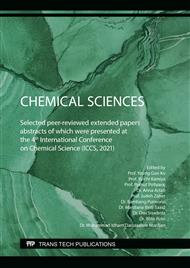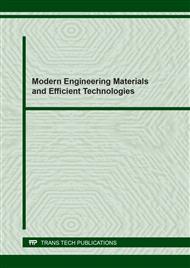[1]
E.E. Ebrahiem, M.N. Al-Maghrabi, A.R. Mobarki, Removal of organic pollutants from industrial wastewater by applying photo-Fenton oxidation technology, Arabian J. Chem. 10 (2017) S1674–S1679.
DOI: 10.1016/j.arabjc.2013.06.012
Google Scholar
[2]
F.Z. Yehia, G. Eshaq, A.M. Rabie, A.H. Mady, A.E. ElMetwally, Phenol degradation by advanced Fenton process in combination with ultrasonic irradiation, Egypt. J. Pet. 24 (2015), 13–18.
DOI: 10.1016/j.ejpe.2015.03.002
Google Scholar
[3]
S. Miralles-Cuevas, I. Oller, J.A.S. Pérez, S. Malato, Removal of pharmaceuticals from MWTP effluent by nanofiltration and solar photo-Fenton using two different iron complexes at neutral pH, Water Res. 64 (2014) 23–31.
DOI: 10.1016/j.watres.2014.06.032
Google Scholar
[4]
E. Ortega-Gómez, P. Fernández-Ibáñez, M.M. Ballesteros Martín, M.I. Polo-López, B. Esteban García, J.A. Sánchez Pérez, Water disinfection using photo-Fenton: Effect of temperature on Enterococcus faecalis survival, Water Res. 46 (2012), 6154–6162.
DOI: 10.1016/j.watres.2012.09.007
Google Scholar
[5]
A. Azhdarpoor, R. Hoseini, M. Dehghani, Leaching Zn, Cd, Pb, and Cu from wastewater sludge using Fenton process, J. Health Sci. Surveill. Syst. 3 (2015), 153–159.
Google Scholar
[6]
E.T. Wahyuni, R. Roto, M. Sabrina, V. Anggraini, N.F. Leswana, A.C. Veronita, Photodegradation of detergent anionic surfactant in wastewater using UV/TiO2/H2O2 and UV/Fe2+/H2O2 processes, Am. J. Appl. Chem. 4 (2016), 174.
Google Scholar
[7]
E.T. Wahyuni, D. Siswanta, E.K. Kunarti, D. Supraba, S. Budiraharjo, Removal of Pb(II) ions in the aqueous solution by photo-Fenton method, Global NEST J. 21 (2019), 180–186.
DOI: 10.30955/gnj.002936
Google Scholar
[8]
U.J. Ahile, R.A. Wuana, A.U. Itodo, R. Sha'Ato, R.F. Dantas, A review on the use of chelating agents as an alternative to promote photo-Fenton at neutral pH: Current trends, knowledge gap and future studies, Sci. Total Environ. 710 (2020), 134872.
DOI: 10.1016/j.scitotenv.2019.134872
Google Scholar
[9]
N. Kishimoto, T. Kitamura, M. Kato, H. Otsu, Influence of chelating agents on Fenton-type reaction using ferrous ion and hypochlorous acid, J. Water Environ. Nanotechnol. 11 (2013), 21–32.
DOI: 10.2965/jwet.2013.21
Google Scholar
[10]
J.L. Buitrago, J. Sanabria, H.M. Gútierrez-Zapata, F.J. Urbano-Ceron, A. García-Barco, P. Osorio-Vargas, Julián A. Rengifo-Herrera, Photo-Fenton process at natural conditions of pH, iron, ions, and humic acids for degradation of diuron and amoxicillin, Environ. Sci. Pollut. Res. 27 (2020), 1608–1624.
DOI: 10.1007/s11356-019-06700-y
Google Scholar
[11]
F.Z. Yehia, M.H. Helal, O. Ali, A.M. Elfadly, A.H. Mady, A.A. Roshdy, Catalytic degradation of phenol using a different chelating agent at near-neutral pH in modified-Fenton process, Egypt. J. Chem. 56 (2013), 199–212.
DOI: 10.21608/ejchem.2013.1108
Google Scholar
[12]
Y. Pan, H. Guo, M. Zhou, Y. Zhang, Y. Tian, W. Wang, EDTA enhanced removal of sulfamethazine by pre-magnetized Fe0 without oxidant addition, Chem. Eng. J. 372 (2019), 905–916.
DOI: 10.1016/j.cej.2019.04.211
Google Scholar
[13]
P. Villegas-Guzman, S. Giannakis, R.A. Torres-Palma, C. Pulgarin, Remarkable enhancement of bacterial inactivation in wastewater through the promotion of solar photo-Fenton at near-neutral pH by natural organic acids, Appl. Catal., B 205 (2017), 219–227.
DOI: 10.1016/j.apcatb.2016.12.021
Google Scholar
[14]
G. Subramanian, G. Madras, Introducing saccharic acid as an efficient iron chelate to enhance photo-Fenton degradation of organic contaminants, Water Res. 104 (2016), 168–177.
DOI: 10.1016/j.watres.2016.07.070
Google Scholar
[15]
K. O'Dowd, S.C. Pillai, Photo-Fenton disinfection at near-neutral pH: Process, parameter optimization and recent advances, J. Environ. Chem. Eng. 8 (2020), 104063.
DOI: 10.1016/j.jece.2020.104063
Google Scholar
[16]
M.B. Miranzadeh, R. Zarjam, R. Dehghani, M. Haghighi, H.Z. Badi, M.A. Marzaleh, A.M. Tehrani, Comparison of Fenton and photo-Fenton processes for removal of linear alkylbenzene sulfonate (LAS) from aqueous solutions, Pol. J. Environ. Stud. 25 (2016), 1639–1648.
DOI: 10.15244/pjoes/61824
Google Scholar
[17]
A. Jariyanorasade, S. Junyapoon, Factors affecting the degradation of linear alkylbenzene sulfonate by TiO2 assisted photocatalysis and its kinetics, EnvironmentAsia 11 (2018), 45–60.
Google Scholar
[18]
E.T. Wahyuni, I. Istiningsih, A. Suratman, Use of visible light for photodegradation of linear alkyl-benzene sulfonate in laundry wastewater over Ag-doped TiO2, J. Environ. Sci. Technol. 13 (2020), 124–130.
DOI: 10.3923/jest.2020.124.130
Google Scholar




